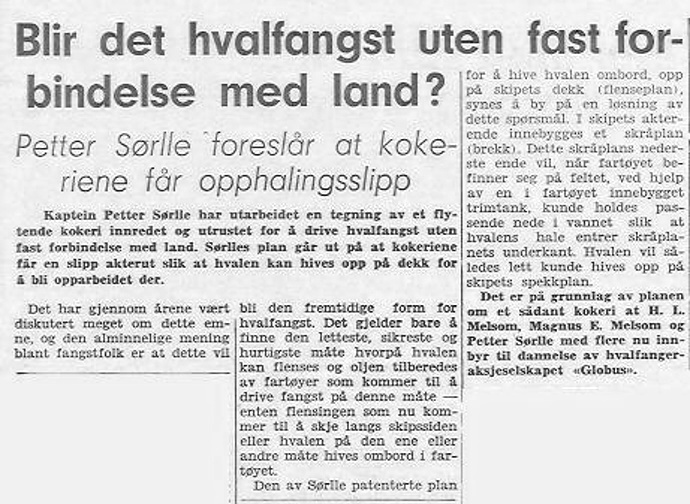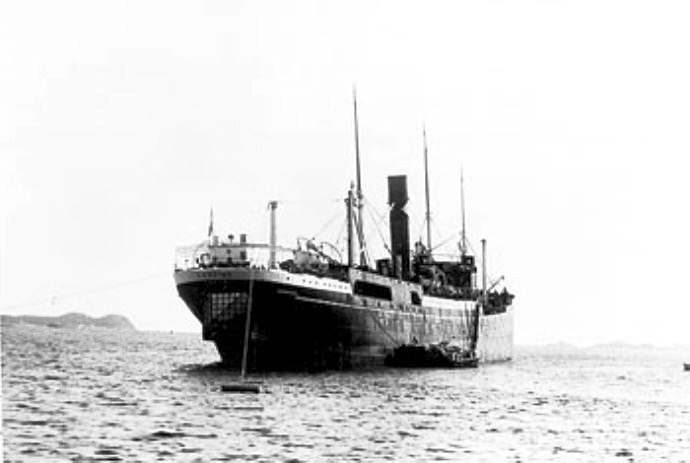Avisutklipp fra Sandefjords Blad i 1924

LVK20019250111801 Lancing (2), Avisutklipp Sandefjords Blad.
Kaptein Petter Sørlle tok ut tilsammen 4 patenter, av disse ikke
mindre enn tre omfattet hvalfangst og opphalings slippen. A/S Framnæs
mek. Værksted ble i denne forbindelse kontaktet. Problemene i
forbindelse med ombygging av LANCING til flytende hvalkokeri ble
løst i nært samarbeide med Mr. Ole Wegger på verkstedet, og kaptein
Petter Sørlle. Sørlle hadde da hatt mye motgang angående oppfinnelsen,
inntil H. G. Melsom fikk se forslaget og forstod hva det kunne innebære.
På forespørsel fra en av representantene i det nyetablerte
Hvalfangstselskapet Globus AS, skipsreder Anders Jahre, konstruerte man
en enkel utbygning og satte tilbake den aktre delen – en konstruksjon
som gjorde det mulig å kutte ned på akterdelen, roret og rorstammen, og
i tillegg flytte styremaskinen og kjetting overføringen til rorflyndren
ned i utbygget, på en slik måte at opphalingsslippen kunne ledes over
styremaskinrommet og ned til vannlinjen. Kontrollen av styremaskinen
blir effektuert fra navigasjonsbroen via en telemotor. A/S Framnæs mek.
Værksted hadde mye av æren for at dette ble en vellykket ombygging.
Modellen som ble laget i januar 1925 og tegningen til Lloyds'
ble overrakt
Kommandør
Chr.Christensen's Hvalfangstmuseum
i Sandefjord og en kopi av den til Norsk Skipsfartsmuseum i Oslo. Denne
løsningen hadde stor betydning for alle etterfølgende spesial bygde
nybygde hvalkokerier med den karakteriske opphalingsslippen akterut.
Denne ombygging hadde stor betydning for konstruksjonen av de
etterfølgende kokerier som ble bygget. Hvalkokerier som KOSMOS og
samme år VIKINGEN for firma Johan Rasmussen & Co var et tydelig
bevis på dette. Disse nye fartøy markerte en ny tid med
industrialisering av denne industrien. Siden kom også kokerier som
SIR JAMES CLARK ROSS, VESTFOLD og SVEND FOYN hvilket
satte en standard for senere hvalkokerier som ble bygget for andre
selskaper.

LVK20019250120002 DS/Flk LANCING. Bilde via Steinar Norheim, Siljan
In English:
Captain
Petter Sørlle took out altogether 4 patents. Of these, no less than
three regarding the whaling-slip. Mr. Sørlle got the idea patented, but
the technical solutions and shaping of the slip is due to A/S Framnæs
mek. Værksted, represented by Mr. Ole Wegger in close cooperation with
Capt. P. Sørlle in the conversion of factory LANCING. Capt. P.
Sørlle was not taken serious by his new patent, until it came on the
desk of Mr. H. G. Melsom. He understood the consequences of this patent.
On request of a representative of the newly established whaling
company Globus A/S, shipowner Anders Jahre, Framnæs constructed a simple
outbuilding and readapted the after part. A construction made possible
by cutting down of the sternpost, rudder and the rudderstock, as well as
removal of the steering machinery and chain transmission to the
rudder-quadrant down in the outbuilding, which in the main is at the
deep loading line, in such a way that the hauling-up slipway could be
led over the steering-machine room and down to the water-line. The
control of the steering-machine is effected from the navigating bridge
by a telemotor. The new installation was a success from the start.
The model made at A/S Framnæs mek. Værksted in January 1925 and
Lloyds' draft have been presented to
Commander
Chr.Christensen's Whaling Museum
in Sandefjord and a copy of it to the Norwegian Maritime Museum, Oslo.
This solution has been of fundamental importance for all subsequent
factory ships with whaling-slip at the stern.
Later special designed ships as KOSMOS and at the same
year, VIKINGEN for the whaling company Johan Rasmussen & Co. was
a direct result of the successful experience with the conversion of
LANCING. These new vessels marked a decisive turning point for
industrialization within the whaling industry. New ships was created,
and both these ships and later also for SIR JAMES CLARK ROSS,
VESTFOLD, and SVEND FOYN which has formed the prototype for
the later whaling factory ships built for foreign account.